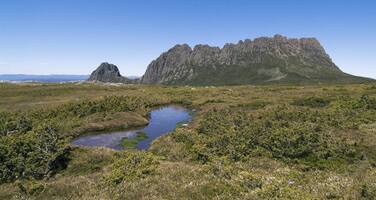Tasmanian Wilderness
Factors affecting the property in 1997*
- Forestry /wood production
- Ground transport infrastructure
Factors* affecting the property identified in previous reports
- Potential construction of a dam (issue resolved)
- Commercial logging in areas adjacent to the World Heritage property
- Roading activities adjacent to the site
International Assistance: requests for the property until 1997
Total amount approved : 0 USD
Missions to the property until 1997**
Information presented to the Bureau of the World Heritage Committee in 1997
IUCN said that a thematic methodology for identifying World Heritage values by an independent expert panel had been exemplary in its approach and that this had been followed by an audit to ensure that all the information was available to enable informed decisions to be made. The allocation of public forest land for production and protection had been made at a political level and this had led to trade-offs. The outcome offered the potential of some modest boundary improvements to the site, although the agreement did not meet IUCN aspirations and would not be welcomed by many of its members. The outcome of the agreement is that threats to the integrity of the site remain. The 20-year agreement, specified further joint action between the two governments before any proposals for extensions to the World Heritage site could be expected.
Australia responded by expressing its appreciation of the direct role played by the IUCN Advisor in the scientific work that led to the outcome. The Australian Government felt that the outcome of the RFA was a major gain for conservation in Tasmania.
In general terms, Australia noted that the Minister of the Environment had responded in detail to all the above issues. Australia had a current programme to spend $1.5 Billion on environmental repair and enhancement and specifically would be spending approximately $ 21 Million on World Heritage this year.
Finally, the IUCN Report noted that their National Committee has offered to perform an "audit function" for reporting on the conservation status for all Australian World Heritage sites. These annual reports will be available for meetings of the Bureau and Committee in 1998.
Conservation issues presented to the World Heritage Committee in 1997
At its twenty-first ordinary session in June 1997, the Bureau, based on written and oral presentations made by IUCN, noted several positive developments with regard to the state of conservation of the following World Heritage sites: Tasmanian Wilderness, Uluru-Kata Tjuta National Park and the Great Barrier Reef.
The Australian authorities have been requested to provide, before 15 October 1997, a copy of the Regional Forest Agreement and a report on the relevance of that Agreement for the maintenance of the integrity of the Tasmanian Wilderness.
Since the conclusion of the twenty-first session of the Bureau in June 1997 however, the following communications, addressed to the Chairperson of the World Heritage Committee, were received by the Centre:
- from the Australian Conservation Foundation (ACF) highlighting the actual and potential threats to the integrity of the Kakadu National Park, arising from the proposal to mine the Jabiluka uranium deposit located within the outer boundaries of the Park; and
- from the Friends of Hinchinbrook Society in Queensland, Australia, highlighting threats to the Great Barrier Reef World Heritage Area due to developments in the Hinchinbrook area and requesting the Committee to consider including the Great Barrier Reef in the List of World Heritage in Danger.
These communications were transmitted to the Chairperson, the Permanent Delegate of Australia to UNESCO and IUCN for their review and comments.
Analysis and Conclusion by World Heritage Centre and the Advisory Bodies in 1997
The Bureau may wish to examine information that may be available at the time of its session and take appropriate action thereupon.
Summary of the interventions
Decisions adopted by the Committee in 1997
21 COM VII.C.43
Reports on the State of Conservation of Mixed Properties Noted by the Committee
VII.43 The Committee noted the decisions of the twenty-first extraordinary session of the Bureau as reflected in the Report of the Bureau session (Working Document WHC- 97/CONF.208/4B Section III.B.c), on the following mixed properties:
Kakadu National Park (Australia)
Tasmanian Wilderness (Australia).
Exports
* :
The threats indicated are listed in alphabetical order; their order does not constitute a classification according to the importance of their impact on the property.
Furthermore, they are presented irrespective of the type of threat faced by the property, i.e. with specific and proven imminent danger (“ascertained danger”) or with threats which could have deleterious effects on the property’s Outstanding Universal Value (“potential danger”).
** : All mission reports are not always available electronically.


